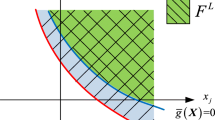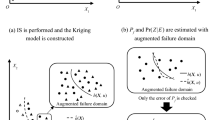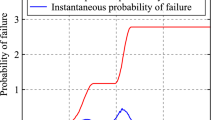Abstract
Reliability analysis aims at quantitatively assessing the risks of structures and infrastructure systems considering various sources of aleatory or epistemic uncertainties. This concept can be interpreted as reliability updating (RU) to track the change of risks, fusing new data emerged in the operation period. Optimal allocation of resources can be therefore prepared for reasonable maintenance and rehabilitation. In the state-of-the-art method for RU with equality information, auxiliary random variables are introduced to transform the problem into an inequality one. However, the joint events derived in aforementioned approach are typically very rare, which can be computationally cumbersome via simulation techniques. To enhance the performance of RU with equality information, this paper proposes a new reliability updating approach that decomposes the joint event term into two separate multipliers and subsequently computes conditional probability through subset simulation (SS). Moreover, this work analyzes the statistical properties for RU through SS. An adaptive manner is proposed to dynamically adjust the batch sample size for each subset so that the consistency of simulation results can be ensured. Compared to past SS-based reliability updating approaches, the proposed method is computationally easier to handle and substantially more robust. Three numerical examples together with a practical application of structural health monitoring are investigated to demonstrate the computational superiority of the proposed method.















Similar content being viewed by others
Abbreviations
- \(c\) :
-
A constant required to formulate the acceptance domain in rejection sampling
- \(F\) :
-
The failure event
- \(F_{i}\) :
-
The subset failure event \(\left( {i = 1,2, \ldots ,m} \right)\)
- \(f_{{\varepsilon_{e} }}\) :
-
The probability density function of \(\varepsilon_{e}\)
- \(f_{{\varepsilon_{s} }}\) :
-
The probability density function of \(\varepsilon_{s}\)
- \(g( \cdot )\) :
-
The performance function
- \(h( \cdot )\) :
-
The limit state function after introducing \(U\) for the RU with equability information
- \(J( \cdot )\) :
-
The limit state function of \(F \cap Z\)
- \(L( \cdot )\) :
-
The likelihood function
- \(m_{s}\) :
-
The measurement of a property of the system
- \(m_{e}\) :
-
The measurement of a property of the external loading
- \(N_{F \cap Z}\) :
-
The number of simulations of performance function for estimating \({\text{ Pr}}\left( {F \cap Z} \right)\) with SS
- \(N_{F}\) :
-
The number of simulations of performance function for estimating \({\text{ Pr}}\left( F \right)\) with SS
- \(N_{Z}\) :
-
The number of simulations of performance function for estimating \({\text{ Pr}}\left( Z \right)\) with SS
- \(N_{ss}^{*}\) :
-
The number of samples in each subset in the last iteration
- \(\Delta N_{ss}\) :
-
The number of extra sampled added by MCMC
- \({\text{Pr}}\left( F \right)\) :
-
The prior probability of failure
- \({\text{Pr}}\left( {F{|}Z} \right)\) :
-
The updated probability of failure with information \(Z\)
- \({\text{Pr}}\left( {F \cap Z} \right)\) :
-
The probability of the joint even \(F \cap Z\)
- \({\text{Pr}}\left( Z \right)\) :
-
The probability of observing the information \(Z\)
- \({\text{Pr}}\left( {Z{|}F} \right)\) :
-
The probability of observing the information \(Z\) if the failure event occurs
- \(P\) :
-
Representing a standard uniform variable
- \(p\) :
-
Representing a realization of a uniform variable
- \(p_{i}\) :
-
The intermediate probability of failure for subset simulation
- \(p_{i}^{*}\) :
-
The updated intermediate probability of failure by adding external samples
- \(S^{i}\) :
-
The set of samples for each subfailure events \(\left( {i = 1,2, \ldots ,m} \right)\)
- \(U\) :
-
Representing a standard normal variable
- \(u\) :
-
Representing a realization of a Gaussian random variable
- \({\varvec{X}}\) :
-
The vector of random variables
- \(Z\) :
-
The observed information
- \(\varepsilon_{e}\) :
-
The measurement error for \(m_{s}\)
- \(\varepsilon_{s}\) :
-
The measurement error for \(m_{e}\)
- \({\Theta }\left( {\varvec{X}} \right)\) :
-
The function parameterized by \({\varvec{X}}\) with a realization notation \({\uptheta }\)
- \({\Theta }_{e} \left( {\varvec{X}} \right)\) :
-
Representing the uncertainty of the external loading
- \({\Theta }_{s} \left( {\varvec{X}} \right)\) :
-
Representing the uncertainty of the system characteristic
- \(\Omega_{f}\) :
-
The target domain for the subset simulation
- \(\Omega_{i}\) :
-
The subset domain \(\left( {i = 1,2, \ldots ,m} \right)\)
- \(N_{F|Z}^{{\text{R}}}\) :
-
The number of simulations of performance function for estimating \({\text{ Pr}}\left( {F|Z} \right)\) with RUSS
- \(N_{F|Z}^{{{\text{OR}}}}\) :
-
The number of simulations of performance function for estimating \({\text{ Pr}}\left( {F|Z} \right)\) with Opt-RUSS
- \({\text{COV(}} \cdot {)}\) :
-
The coefficient of variation for an estimator
- \({\text{E(}} \cdot {)}\) :
-
The mean of an estimator
- \({\text{Var(}} \cdot {)}\) :
-
The variance of an estimator
References
Au SK, Beck JL (1999) A new adaptive importance sampling scheme for reliability calculations. Struct Saf 21(2):135–158
Au S-K, Beck JL (2001) Estimation of small failure probabilities in high dimensions by subset simulation. Probab Eng Mech 16(4):263–277
Au SK, Beck JL (2003) Subset simulation and its application to seismic risk based on dynamic analysis. J Eng Mech 129(8):901–917
Echard B, Gayton N, Lemaire M (2011) AK-MCS: an active learning reliability method combining Kriging and Monte Carlo simulation. Struct Saf 33(2):145–154. https://doi.org/10.1016/j.strusafe.2011.01.002
Fishman G (2013) Monte Carlo: concepts, algorithms, and applications. Springer, New York. Accessed 12 May 2017. https://books.google.com/books?hl=zh-CN&lr=&id=dogHCAAAQBAJ&oi=fnd&pg=PR5&dq=Fishman+GS.+Monte+Carlo:+concepts,+algorithms,+and+applications.+New+York:+Springer%3B+1996.&ots=tek4yqkYv9&sig=7EeAqPb78nlQi_gdFZ6Ru_I8VSM
Gollwitzer S, Kirchgäßner B, Fischer R, Rackwitz R (2006) PERMAS-RA/STRUREL system of programs for probabilistic reliability analysis. Struct Saf 28(1):108–129. https://doi.org/10.1016/j.strusafe.2005.03.008
Hohenbichler M, Rackwitz R (1988) Improvement of second-order reliability estimates by importance sampling. J Eng Mech 114(12):2195–2199
Kiureghian AD, Stefano MD (1991) Efficient algorithm for second-order reliability analysis. J Eng Mech 117(12):2904–2923. https://doi.org/10.1061/(ASCE)0733-9399(1991)117:12(2904)
Li Y, Sun L, Zhang W, Nagarajaiah S (2021) Bridge damage detection from the equivalent damage load by multitype measurements. Struct Control Health Monit 28(5):e2709. https://doi.org/10.1002/stc.2709
Luque J, Straub D (2016) Reliability analysis and updating of deteriorating systems with dynamic Bayesian networks. Struct Saf 62:34–46. https://doi.org/10.1016/j.strusafe.2016.03.004
Marelli S, Schöbi R, Sudret B. UQLab user manual—structural reliability (rare events estimation). p 60
Nikolaidis E, Ghiocel DM, Singhal S (2004) Engineering design reliability handbook. CRC Press, Boca Raton. https://www.crcpress.com/Engineering-Design-Reliability-Handbook/Nikolaidis-Ghiocel-Singhal/p/book/9780849311802. Accessed 18 May 2018
Papaioannou I, Straub D (2012) Reliability updating in geotechnical engineering including spatial variability of soil. Comput Geotech 42:44–51. https://doi.org/10.1016/j.compgeo.2011.12.004
Papaioannou I, Betz W, Zwirglmaier K, Straub D (2015) MCMC algorithms for Subset Simulation. Probab Eng Mech 41:89–103. https://doi.org/10.1016/j.probengmech.2015.06.006
Rackwitz R, Flessler B (1978) Structural reliability under combined random load sequences. Comput Struct 9(5):489–494. https://doi.org/10.1016/0045-7949(78)90046-9
Rafiq MI, Chryssanthopoulos MK, Sathananthan S (2015) Bridge condition modelling and prediction using dynamic Bayesian belief networks. Struct Infrastruct Eng 11(1):38–50. https://doi.org/10.1080/15732479.2013.879319
Ramírez PAP, Utne IB (2015) Use of dynamic Bayesian networks for life extension assessment of ageing systems. Reliab Eng Syst Saf 133:119–136. https://doi.org/10.1016/j.ress.2014.09.002
Rubinstein RY, Kroese DP (2016) Simulation and the Monte Carlo method. Wiley, New York. Accessed 12 May 2017. https://books.google.com/books?hl=zh-CN&lr=&id=r2VODQAAQBAJ&oi=fnd&pg=PR1&dq=Rubinstein+RY.+Simulation+and+the+Monte%E2%80%93Carlo+method.+New+York:+Wiley%3B+1981.&ots=13YWiw6b-8&sig=HQP5so5XRDQRaKDv9LsxXcLBTpA
Schneider R, Thöns S, Straub D (2017) Reliability analysis and updating of deteriorating systems with subset simulation. Struct Saf 64:20–36. https://doi.org/10.1016/j.strusafe.2016.09.002
Schweckendiek T, Vrouwenvelder ACWM (2013) Reliability updating and decision analysis for head monitoring of levees. Georisk 7(2):110–121. https://doi.org/10.1080/17499518.2013.791034
Sindel R, Rackwitz R (1998) Problems and solution strategies in reliability updating. J Offshore Mech Arct Eng 120(2):109–114. https://doi.org/10.1115/1.2829524
Song C, Wang Z, Shafieezadeh A, Xiao R (2022) BUAK-AIS: efficient bayesian updating with active learning kriging-based adaptive importance sampling. Comput Methods Appl Mech Eng 391:114578. https://doi.org/10.1016/j.cma.2022.114578
Špačková O, Straub D (2013) Dynamic Bayesian network for probabilistic modeling of tunnel excavation processes. Comput-Aided Civ Infrastruct Eng 28(1):1–21. https://doi.org/10.1111/j.1467-8667.2012.00759.x
Straub D (2009) Stochastic modeling of deterioration processes through dynamic bayesian networks. J Eng Mech 135(10):1089–1099. https://doi.org/10.1061/(ASCE)EM.1943-7889.0000024
Straub D (2011) Reliability updating with equality information. Probab Eng Mech 26(2):254–258. https://doi.org/10.1016/j.probengmech.2010.08.003
Straub D, Der Kiureghian A (2010a) Bayesian network enhanced with structural reliability methods: methodology. J Eng Mech 136(10):1248–1258. https://doi.org/10.1061/(ASCE)EM.1943-7889.0000173
Straub D, Der Kiureghian A (2010b) Bayesian network enhanced with structural reliability methods: application. J Eng Mech 136(10):1259–1270. https://doi.org/10.1061/(ASCE)EM.1943-7889.0000170
Straub D, Papaioannou I (2015) Bayesian updating with structural reliability methods. J Eng Mech 141(3):04014134. https://doi.org/10.1061/(ASCE)EM.1943-7889.0000839
UQLab input manual (2017) UQLab, the framework for uncertainty quantification, May 13, 2017. http://www.uqlab.com/userguideinput. Accessed 14 May 2017
Wang Z, Shafieezadeh A (2019a) Real time high-fidelity reliability updating with equality information using adaptive Kriging. Reliab Eng Syst SaF 195:106735. https://doi.org/10.1016/j.ress.2019.106735
Wang Z, Shafieezadeh A (2019b) REAK: reliability analysis through error rate-based adaptive Kriging. Reliab Eng Syst Saf 182:33–45. https://doi.org/10.1016/j.ress.2018.10.004
Wang Z, Shafieezadeh A (2019c) ESC: an efficient error-based stopping criterion for kriging-based reliability analysis methods. Struct Multidisc Optim 59(5):1621–1637. https://doi.org/10.1007/s00158-018-2150-9
Wang Z, Shafieezadeh A (2020) On confidence intervals for failure probability estimates in Kriging-based reliability analysis. Reliab Eng Syst Saf 196:106758. https://doi.org/10.1016/j.ress.2019.106758
Wang Z, Shafieezadeh A (2021) Metamodel-based subset simulation adaptable to target computational capacities: the case for high-dimensional and rare event reliability analysis. Struct Multidisc Optim 64:649–675. https://doi.org/10.1007/s00158-021-02864-9
Wang X, Mazumder RK, Salarieh B, Salman AM, Shafieezadeh A, Li Y (2022) Machine learning for risk and resilience assessment in structural engineering: progress and future trends. J Struct Eng 148(8):03122003. https://doi.org/10.1061/(ASCE)ST.1943-541X.0003392
Wang X, Luo F, Ye A (2023) A holistic framework for seismic analysis of extended pile-shaft-supported bridges against different extents of liquefaction and lateral spreading. Soil Dyn Earthq Eng 170:107914. https://doi.org/10.1016/j.soildyn.2023.107914
Xiao X, Li Q, Wang Z (2022) A novel adaptive importance sampling algorithm for Bayesian model updating. Struct Saf 97:102230. https://doi.org/10.1016/j.strusafe.2022.102230
Young-Joo L, Junho S (2014) System reliability updating of fatigue-induced sequential failures. J Struct Eng 140(3):04013074. https://doi.org/10.1061/(ASCE)ST.1943-541X.0000836
Zhang C, Wang Z, Shafieezadeh A (2021) Error quantification and control for adaptive kriging-based reliability updating with equality information. Reliab Eng Syst Saf 207:107323. https://doi.org/10.1016/j.ress.2020.107323
Zhao Y, Wang Z (2022) Subset simulation with adaptable intermediate failure probability for robust reliability analysis: an unsupervised learning-based approach. Struct Multidisc Optim 65(6):172. https://doi.org/10.1007/s00158-022-03260-7
Acknowledgements
This research was supported by the National Natural Science Foundation of China (No. 52308196) and New Faculty Basic Research Capability Enhancement Program (No. 590123060). It was also partially funded by China Postdoctoral Science Foundation (No. 2022M710886) and Guangdong Provincial Key Laboratory of Green Construction and Intelligent Operation & Maintenance for Offshore Infrastructure. Any opinions, findings, and conclusions or recommendations expressed in this paper are those of the author and do not necessarily reflect the views of the support. The support is greatly appreciated.
Author information
Authors and Affiliations
Corresponding author
Ethics declarations
Conflict of interest
The authors declare that they have no known competing financial interests or personal relationships that could have appeared to influence the work reported in this paper.
Replication of results
The algorithms and step-by-step implementation approach for the proposed Opt-RUSS are elaborated in the paper. Readers can use MATLAB and UQLab package to implement the algorithms and generate the results presented in the paper. The codes can be accessed upon reader’s requirement.
Additional information
Responsible Editor: Zhen Hu
Publisher's Note
Springer Nature remains neutral with regard to jurisdictional claims in published maps and institutional affiliations.
Rights and permissions
Springer Nature or its licensor (e.g. a society or other partner) holds exclusive rights to this article under a publishing agreement with the author(s) or other rightsholder(s); author self-archiving of the accepted manuscript version of this article is solely governed by the terms of such publishing agreement and applicable law.
About this article
Cite this article
Wang, Z., Zhao, Y., Song, C. et al. A new interpretation on structural reliability updating with adaptive batch sampling-based subset simulation. Struct Multidisc Optim 67, 7 (2024). https://doi.org/10.1007/s00158-023-03720-8
Received:
Revised:
Accepted:
Published:
DOI: https://doi.org/10.1007/s00158-023-03720-8




